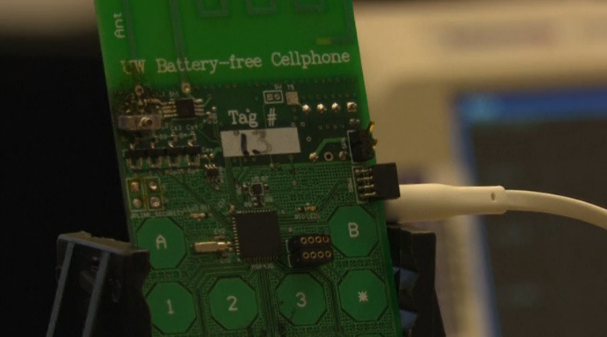
SEATTLE, Washington (Reuters) — Researchers in the United States have developed what they believe is the world’s first battery-free cellphone.
The phone is the work of a group of researchers at the University of Washington in Seattle and works by harvesting tiny amounts of power from radio signals, known as radio frequency or ‘RF’ waves.
At first glance it looks little more than a circuit board with electronics equipment connected to it, but it could be the next major technological leap for mobile phones, the team says.
“This battery-free phone is a major leap in terms of the capabilities of battery-free devices because now we have a streaming device that can continuously talk as well as receive data, which is basically a phone,” explained Shyam Gollakota from the Paul G. Allen School of Computer Science & Engineering.
The prototype is made of commercial, off-the-shelf components and can receive and transmit speech and communicate with a base station. Its operation is currently very basic, and the caller must wear headphones and press a button to switch between talking and listening.
The team’s first challenge was to develop a phone that used considerably less power to make and receive calls, according to researcher Vamsi Talla.
“If you look at a typical cellphone it actually consumes hundreds of milliwatts of power while it’s doing voice calls and it’s impossible to make a device like that to be battery-free. So what we did, as a first challenge, was to actually get that power number down by orders of magnitude,” said Talla.
They achieved that by developing a method to harvest tiny amounts of power, just a few microwatts, from radio signals, known as radio frequency or ‘RF’ waves. This unseen source of power is everywhere, according to Talla.
“Ambient RF waves are all around us so, as an example, your FM station broadcasts radio waves, your AM stations do that, your TV stations, your cellphone towers. They all are transmitting RF waves.”
Perhaps the greatest potential source of RF waves are Wi-fi internet signals, now common at work, homes and many public places.
The researchers say there are plans to develop further prototypes with a low-power screen for texting and even a basic camera. They’re also planning a version of the battery-free phone that uses a tiny solar cell to provide power.
The team sees potential for reaching a wider market with the battery-free technology.
“We are really excited about this technology and the University of Washington has an IP for this and we are looking for avenues to basically commercialize and actually get this into peoples’ hands and actually deploy this system more widely,” he said.
The initiative is not the only one seeking to improve the way that mobile technology is powered. Researchers at the Universities of Bristol and Surrey in Britain are developing supercapacitors, which they believe will eventually allow devices to charge in a period of a few minutes.
The University of Washington team’s research was published in the Proceedings of the Association for Computing Machinery on Interactive, Mobile, Wearable and Ubiquitous Technologies.








